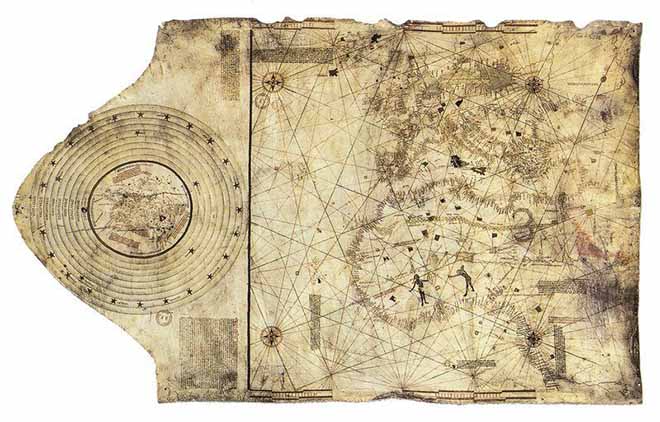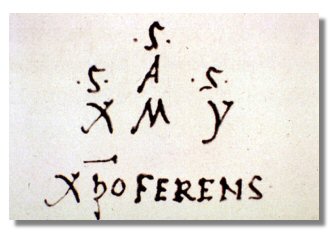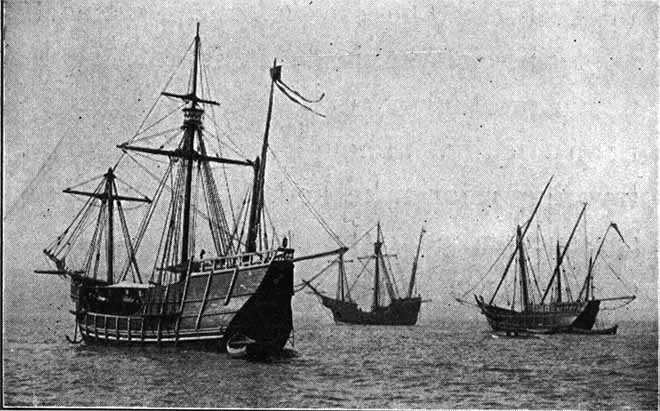Christopher Columbus 1492
The Discovery of America

It was on October 14, 1492 that Christopher Columbus, commanding a fleet of three caravels - small light vessels capable of sailing against the wind and easy to govern - moored after more than two months of ocean voyage on a small island of the archipelago of the Bahamas. Already inhabited for several thousands of years by a Tainos Indian people who nicknamed it Guanahani, Columbus renames it San Salvador, which means Saint-Sauveur in French and which shows his relief to finally see the mainland.
Unconscious of his accomplishment, Christopher Columbus had just demonstrated the veracity of a hypothesis that is several millennia old: the Earth is round. It is only the climax of the life of this great explorer since the history of Columbus is more complex than the simple discovery of the first lands of America.
Christopher Columbus early life

Very young, Christopher Columbus takes interest in navigation and undertakes very long journeys that lead him as far as Africa and Iceland. Some say he was already a freed sailor by the age of 14. This is how Columbus forged his experience and acclimated to ocean life. It was also during this time that the dream of sailing to a new uninhabited continent began to germinate in his mind.
During the hours of solitude that accompany such trips at sea, Christopher Columbus studies the nautical charts and books of great astronomers and mathematicians of the time and begins to refine his vision of the sea, a vision that will eventually make him Admiral. At that time, many people improvised themselves adventurers and navigators but few of them knew the risks of the ocean as Christopher Columbus did.
A risky expedition
A transatlantic crossing is a very risky expedition that requires a lot of resources: boats, crews, provisions ... How could a simple sailor like Columbus have managed to obtain from the Spanish royal family the necessary financing to realize his greatest dream? Some report that the trip would have been financed by the sale of the jewels of Queen Isabella of Castile which were worth a fortune while others state of a close link between Christopher Columbus and Pope Innocent VIII, also from Gene and responsible for the sponsor obtained by Columbus. This last version is all the more credible because a large number of Colombus financiers had close relations with the pope.
A turning point in history
Only three months after the great conquest of the Spaniards at the expense of the Moors on the city of Granada in January 1492, Christopher Columbus is elected commander of a fleet of three caravels which must reach the rich countries of East Asia (India) for commercial and religious purposes. He is named Grand Admiral of the Seas and Viceroy of lands and islands eventually discovered, and Columbus is granted the right to collect one-tenth of the wealth discovered on these new lands. The three small ships forming the armada of the expedition, the Nina, the Pinta, and the Santa Maria have on bord barely a hundred and fifty men.
A new crusade

Christopher Columbus, who called himself "the one who bears Christ", was a strong believer and planted a cross on all lands where his ships docked. He also signed all his writings of a mysterious cryptogram whose meaning remains unknown. This is one of the greatest enigmas associated with this great explorer and has been going on for nearly 500 years. Some claimed that the Columbus Expedition wealth was to be used to fund the project of a new crusade to liberate Jerusalem and the Holy Sepulcher. This hypothesis tends to confirm the version according to which the necessary funds for the crossing were released thanks to the support of Pope Innocent VIII.
Christopher Columbus first voyage

Christopher Columbus first voyage begins on August 3, 1492 at the first light of day ; the three caravels must first reach the Canaries to load the last necessary provisions before undertaking the crossing. Nearly a month later, Columbus decides to head west, pushed by the trade winds. Did the Genoese Admiral think he could reach unknown lands before berthing in India by heading west? It is said that Columbus actually discovered America seven years earlier, in 1485, on an exploratory voyage. If this story is true, Columbus knew in advance that going west, he would find peoples to convert and the wealth needed for the crusade on Holy Land.
Be that as it may, on the 7th of October, after a month's drift, the admiral sees a flock of birds heading south-west, and, feeling his crew exhausted, decides to follow them in the hope that they guide him to the shore. Columbus is right and, a few days later, he docks in San Salvador in the Bahamas. He will then stop in Cuba and Haiti before leaving five months later for Spain, where he will be welcomed as a hero, with a single caravel. Despite great political changes in Spain, Christopher Columbus still manages to organize expeditions until the death of Queen Isabella, in 1504. He died two years later in the greatest of general indifference and his childrens will not see any of the wealth that was to be used to finance the project of crusade on Holy Land.









































































































































































































































































































































